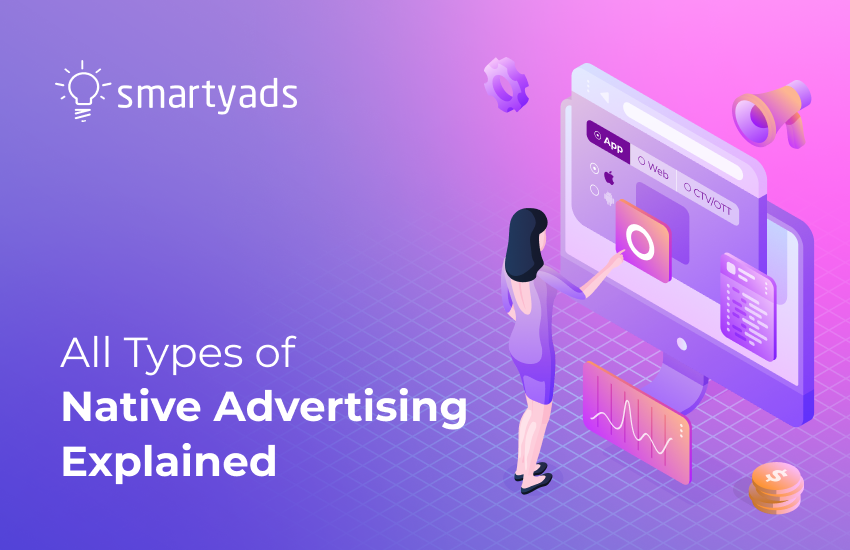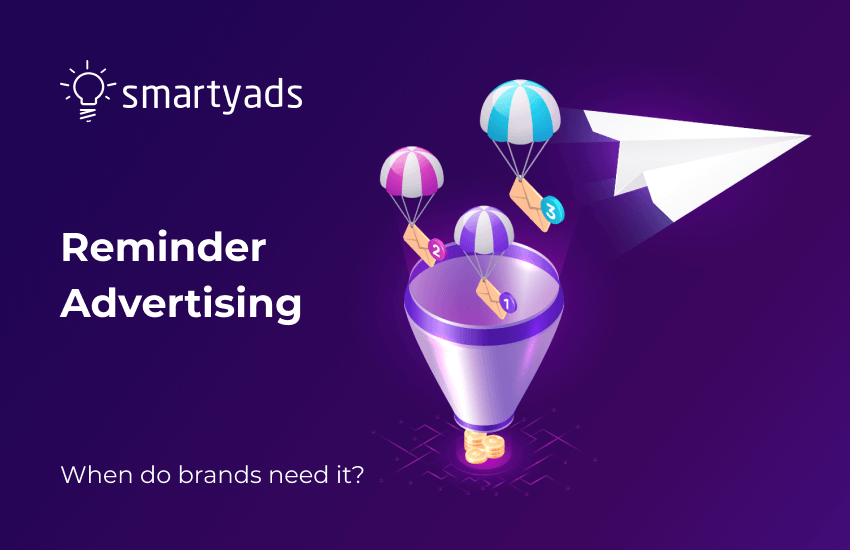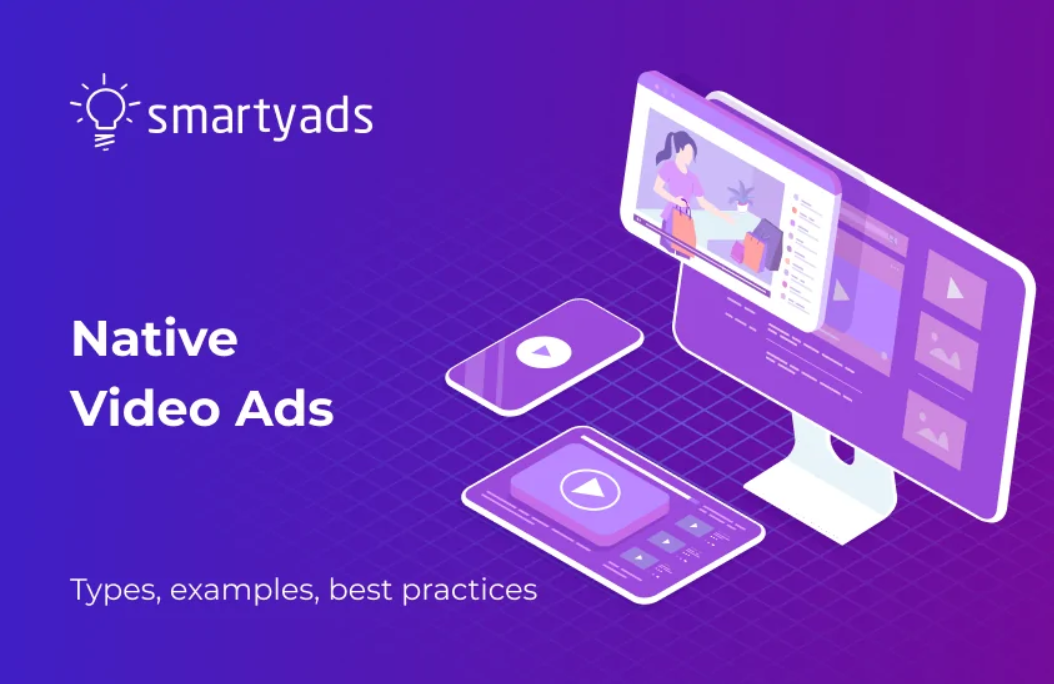Native advertising is often contrasted with traditional advertising. However, today, native advertising is most likely already a form of traditional advertising, as marketers around the world widely use it. Therefore, for every marketer, business owner, and, in general, a person somehow connected with advertising, it is better to know the types and features of native advertising.
This form of advertising is ingeniously designed to harmonize with the platform or channel in which it appears. By adopting the aesthetics, tone, and context of the surrounding content, native advertising effortlessly weaves itself into the fabric of the user's interaction, generating a sense of continuity and relevance.
This inherent compatibility ensures that the advertisement doesn't jolt the user's engagement but rather enhances it.
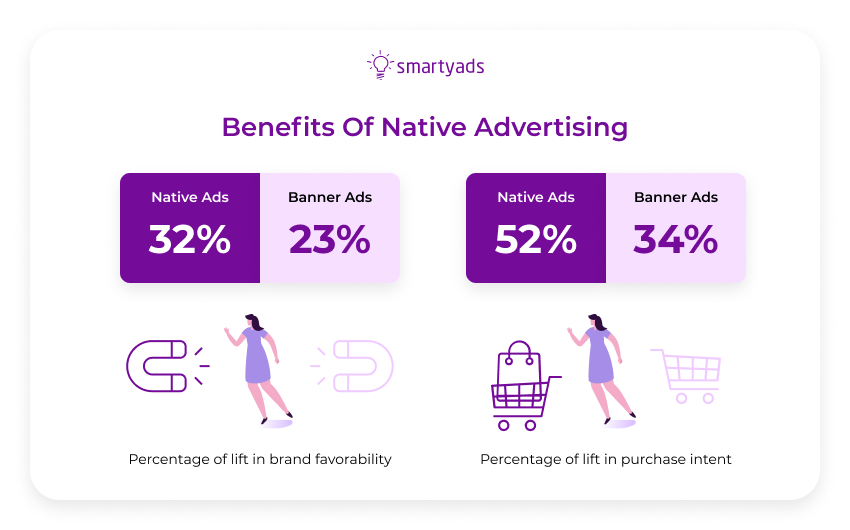
The core principle of native advertising centers on honoring the user's preferences and actions. By tailoring the content to resonate with the user's existing habits and inclinations, native advertising captures attention without triggering resistance.
Its unobtrusive nature makes it a more welcomed presence, fostering a sense of receptivity that's often elusive in more traditional ads. As a bonus, native advertising also helps raise click-through rates.
An interesting fact about native advertising
The native advertising industry dates back to the 19th and 20th centuries. An illustrative instance of this can be found in the work of David Ogilvy, who skillfully employed native advertising principles in his publication "The Oyster Guide".
Within the pages of this guide, Ogilvy expertly delineated the distinctions among nine diverse types of oysters.
Notably, he astutely intertwined his content by suggesting that the enhanced taste of any oyster could be complemented by the consumption of Guinness beer, seamlessly integrating a promotional aspect into the informative narrative.
This early utilization of native advertising demonstrates the art of harmonizing engaging content with subtle brand associations, a practice that continues to evolve and influence contemporary advertising strategies.
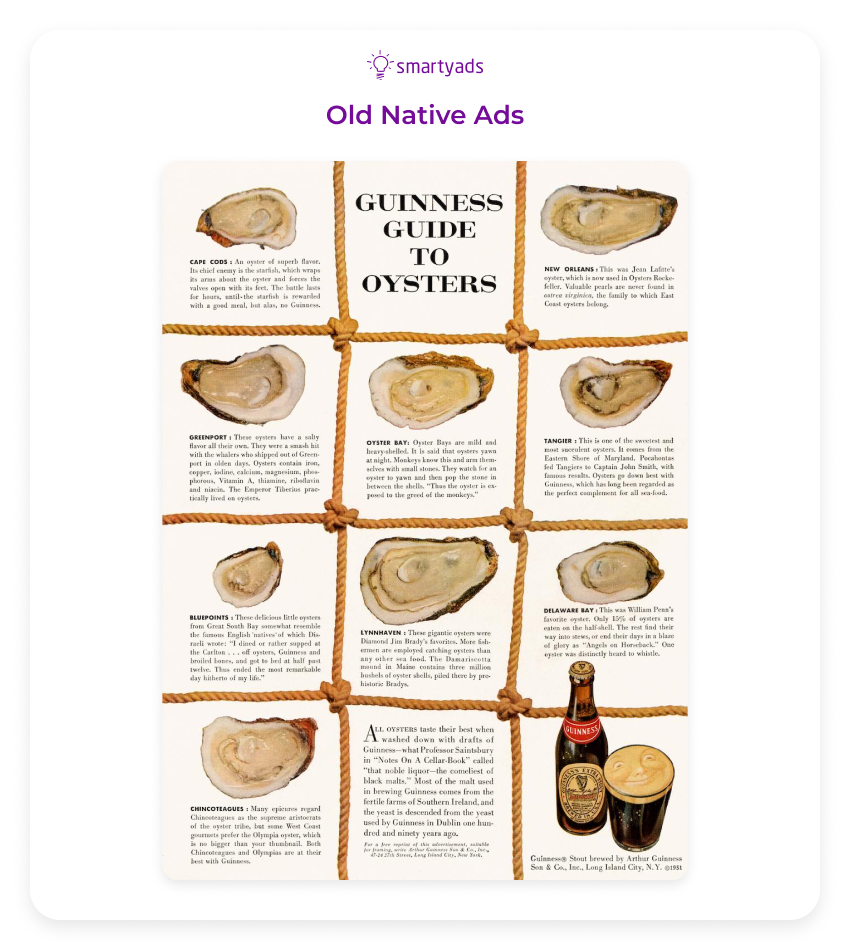
Types of native advertising according to IAB
In its 2019 release of the extensively referenced Native Advertising Playbook, the Interactive Advertising Board (IAB) discerns three fundamental classifications of native advertising:
- In-content/In-feed;
- Content Recommendation Ads;
- Branded/Native Content.
Considering the dynamic pace at which the native advertising domain evolves, the span of four years seems akin to an era.
It is plausible that an updated rendition of the IAB playbook will surface before long. Meanwhile, our focus remains on these foundational native ad formats.

In-content/In-feed Native Ads
In-content/In-feed native ads represent a sophisticated approach to digital advertising, artfully designed to merge with a given platform's organic content seamlessly.
These native ads ingeniously adopt the appearance, style, and context of the surrounding content, ensuring a harmonious user experience. By mirroring the visual and thematic elements of the host platform, in-content/in-feed ads appear as natural extensions of the user's browsing journey.
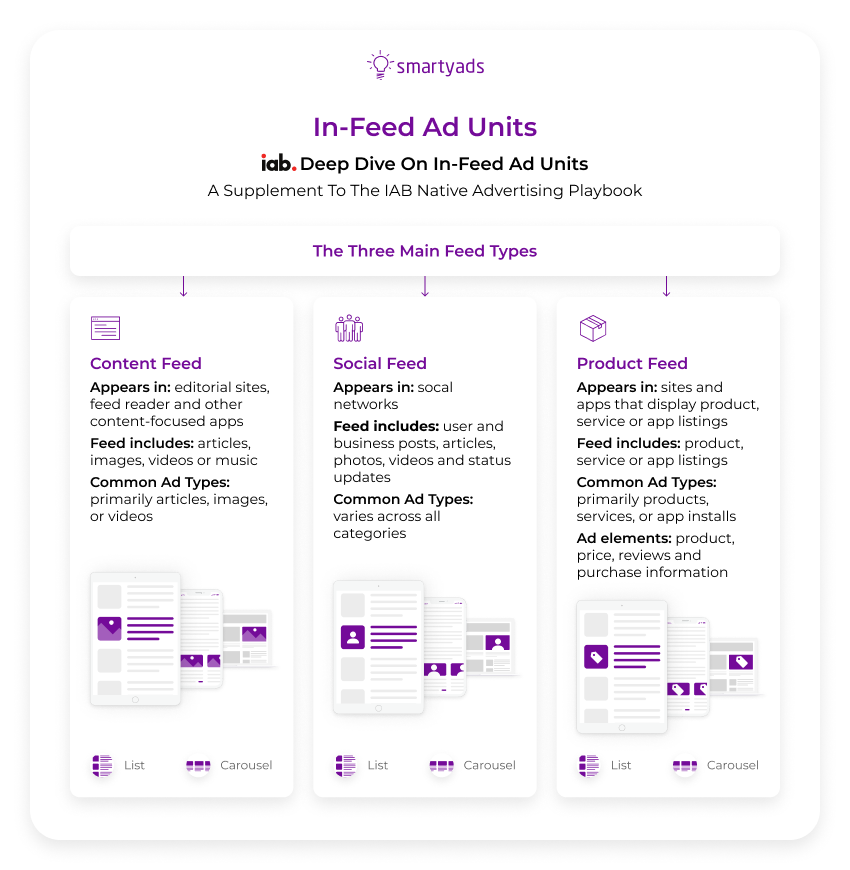
These native ads can appear as banner ads that everyone is familiar with and can be regular text ads or promoted listings.
One notable benefit of this type of native advertising is its subtle presence, which stands in contrast to traditional display ads. As users scroll through their social media feeds, news articles, or other content streams, these native ads flow naturally alongside, providing value and relevance without disrupting the overall browsing experience.
The non-disruptive nature of in-content/in-feed ads fosters higher user engagement and receptivity, as they are more likely to be perceived as informative rather than overtly promotional.
These native ads are versatile in terms of content format. They can comprise images, videos, or even interactive elements, engaging users through compelling storytelling or informative narratives.
By strategically aligning with the user's interests and preferences, in-content/in-feed ads enhance brand visibility, drive engagement, and foster a sense of brand affinity.
As digital marketing continues to evolve, in-content/in-feed ads remain a pivotal tool for marketers seeking to connect with their target audience in a subtle yet impactful manner.
Through integration into the user's online journey, these native ads connect promotion with user interaction, ultimately fostering a smoother and more pertinent native advertising environment.
Content Recommendation Ads
Content Recommendation Native Ads constitute a dynamic facet of native advertising that involves suggesting relevant content to users based on their browsing habits and interests.
These native ads typically appear as widgets or sections at the end of articles, blog posts, or other online content, offering readers additional articles, videos, or resources that align with their preferences.
Content recommendation ads aim to extend user engagement and enhance their experience by providing them with further content that piques their curiosity. These native ad publications leverage sophisticated algorithms and data analytics to understand user behavior and preferences, ensuring that the suggested content is both contextually appropriate and intriguing.
By leveraging the power of personalization, content recommendation native ad posts not only foster deeper user engagement but also contribute to a more seamless integration of promotional content within the user's online journey.
This native ad often serves as a valuable tool for content publishers as well, driving additional page views and extending the user's time on the website.
Branded/Native Content
Sponsored Content represents a strategic fusion of brand messaging and informative content seamlessly embedded within the context of a platform or medium.
This form of native advertising entails creating content that educates, entertains, or informs the audience and aligns harmoniously with the brand's identity and objectives.
Unlike traditional advertising, which often involves overt product promotion, branded content takes a more subtle and value-driven approach.
It seeks to engage the audience by delivering content that resonates with their interests while subtly integrating brand messaging. This content is crafted to provide genuine value, making it more appealing and relevant to the audience.
Sponsored content is a native ad that can take various forms, including articles, videos, podcasts, banner ads, or interactive experiences. Among native ad examples it's possible to name the Netflix podcast about Stranger Things on Spotify.
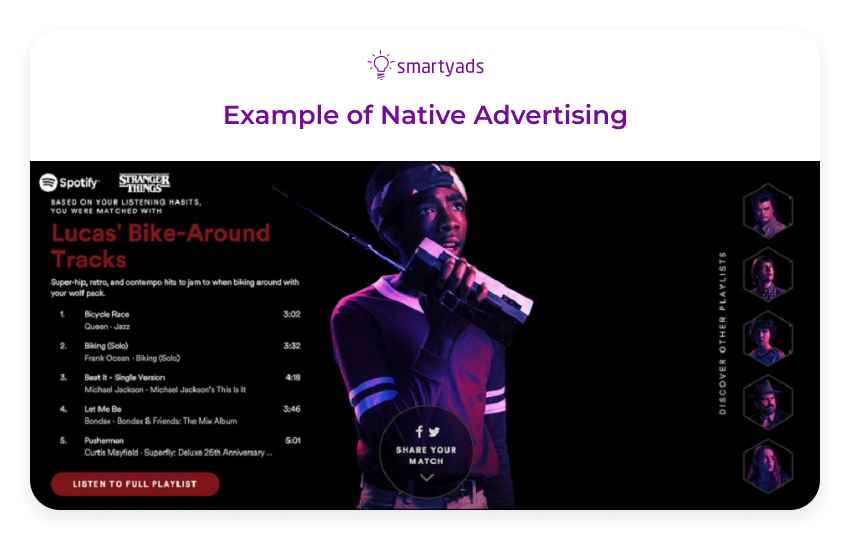
The key lies in ensuring that the content feels authentic, resonates with the audience and seamlessly integrates the brand's values and identity. By doing so, brands can establish a deeper connection with their target audience, enhancing brand awareness and affinity.
One of the distinctive features of branded content is its ability to evoke emotional connections and foster trust.
By delivering valuable and meaningful content, brands can position themselves as authorities or thought leaders in their respective fields, thereby establishing credibility and building a loyal following.
This form of native advertising requires a delicate balance between brand messaging and user experience.
Sponsored content can blur the lines between advertising and organic content, resulting in a more engaging and compelling interaction between brands and consumers.
As the digital landscape continues to evolve, native content remains a compelling avenue for brands to authentically connect with their audience while delivering value-driven messaging.

Other types of native advertising
The IAB is, of course, a recognized expert in the field of online advertising, but their categorization of native advertising is rather general and does not reflect the infinity of possibilities that are available with the help of various native ad formats.
To launch your native advertising campaign, you may need to know about other types of online advertising, and we will talk about them now.
Blogger Evaluations
Bloggers serve as authoritative fountains of information for their followers. Typically, subscribers align with their values and rely on bloggers' viewpoints.
As a result, such evaluations carry greater influence than analogous posts from unfamiliar purchasers on review platforms. Accordingly, bloggers become excellent intermediaries for delivering native advertising.
Central to this phenomenon is the genuine connection bloggers forge with their readers. Unlike the detached, one-size-fits-all approach often seen on review platforms, bloggers interweave their authentic experiences and personal anecdotes into their assessments.
This narrative-driven style enriches the evaluation and encapsulates the subtleties that mere ratings and statistics fail to capture. In this way, the artful presentation of information becomes a cornerstone of the blogger review, transforming it into compelling and engaging content.
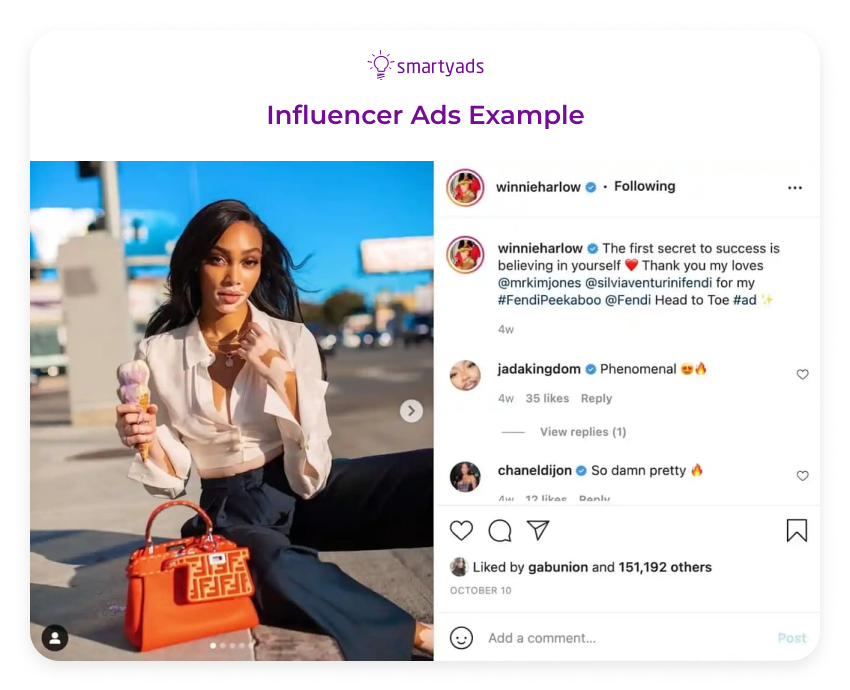
Consider, for instance, a fashion blogger meticulously dissecting the latest trends (as in the above example).
With an expert eye and an innate understanding of their audience's preferences, the blogger delivers a comprehensive analysis and infuses it with their distinctive flair and perspective. This holistic approach resonates deeply with subscribers, elevating the review to a level that transcends a mere critique and becomes a source of inspiration and guidance.
Sponsored articles
Imagine desiring to share your narrative with the discerning audience of a specific online platform.
You possess the expertise to fashion a superior product, while a skilled journalist excels in conveying compelling narratives to captivate the readership.
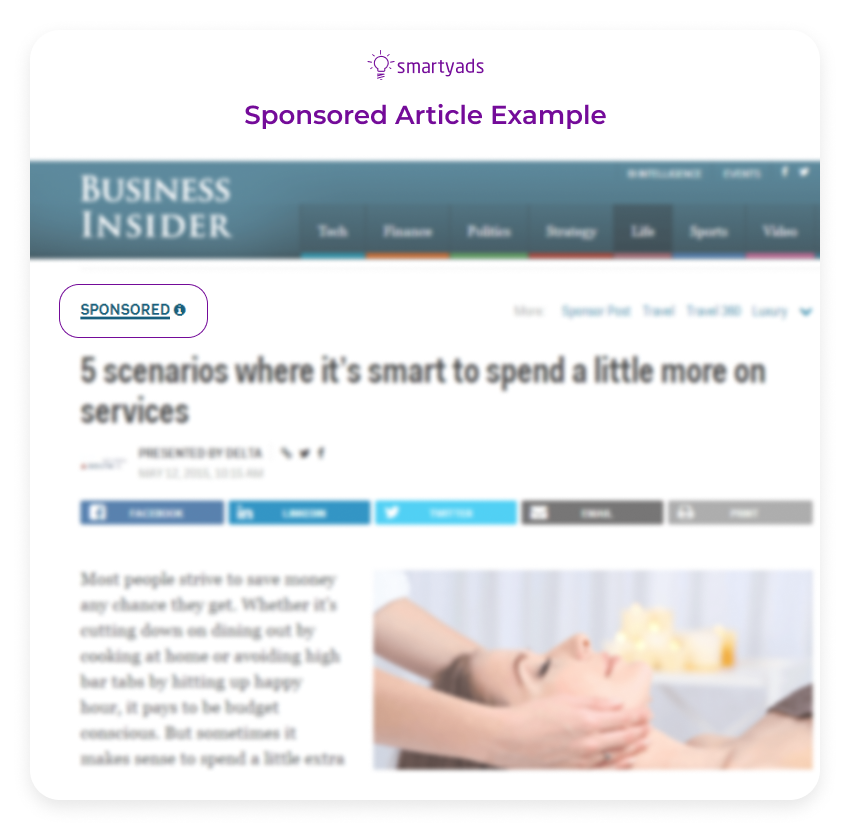
The pinnacle of excellence is attained when the collaboratively conjured content harmonizes the visions of both the client and creator.
The brand assumes the role of a fount of specialized knowledge, and the platform's adept representatives skillfully weave it into a fabric that resonates with the accustomed preferences of their readers or viewers.
Concurrently, the product itself delicately graces the discourse, subtly acknowledged in passing rather than overtly spotlighted.
Promoted Listings
Promoted listings within native ads offer a strategic avenue for enhancing visibility. These listings seamlessly integrate into the fabric of the content, harmonizing with the user experience while spotlighting specific products or services.
Think of promoted listings in native ads as a smart way to get noticed. They fit right into the content you're reading or watching, making them feel like a natural part of the experience.
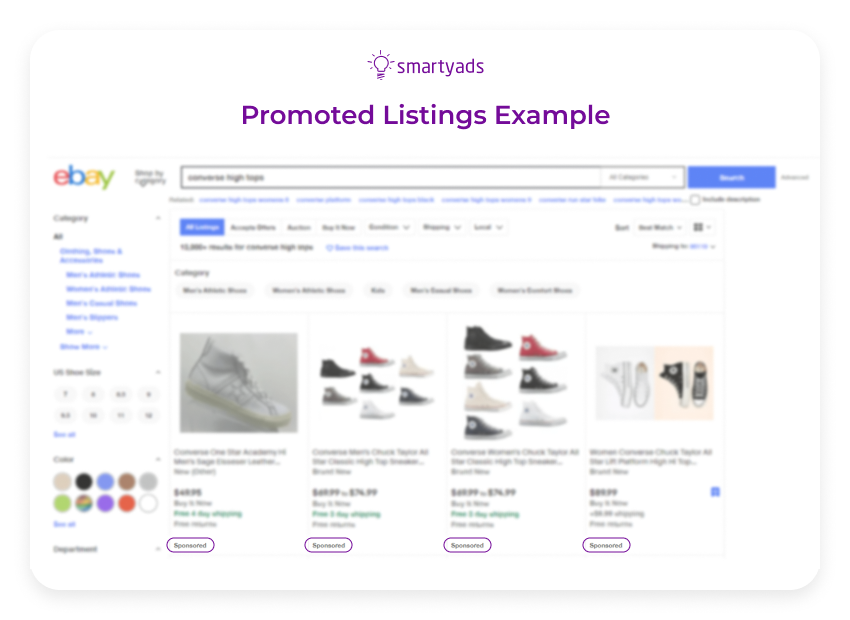
Imagine you're checking out an article or video, and there, nestled in seamlessly, is a promoted listing. Unlike flashy ads that interrupt, these listings blend in, not disturbing your flow.
The magic of promoted listings is that they catch your eye without being pushy. They show you stuff that's related to what you're already enjoying. It's a win-win – you find cool things, and advertisers get more attention.
Promoted listings use the friendly nature of native ads to stand out just enough. This helps you discover interesting stuff while letting advertisers shine. In a world full of information, promoted listings help you find the good stuff without any fuss.
Native Advertising in social media
Native ad posts are considered posts written in the format and style of the community. These native ad posts bear the hallmark of being meticulously crafted to embody the very format and stylistic essence that define the community's unique voice.
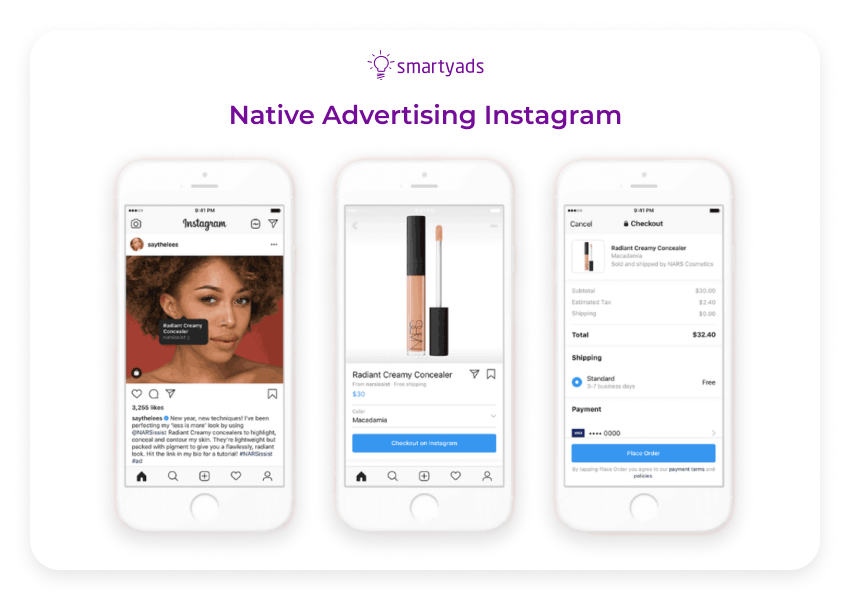
What truly sets native posts apart is their remarkable adaptability — their capacity to coexist with non-advertising content.
This chameleon-like quality is unveiled when one undertakes a subtle transformation: by deftly excising any allusions to the advertising sponsor and deferring any overt linkage to external resources, these posts integrate seamlessly into the ongoing dialogue, rendering the line between promotional and non-promotional content.
Native search ads
Native search ads are like seamless companions to your online searches. Paid search ads blend right into the organic search results you see on platforms like search engines. Imagine them as helpful suggestions that match what you're looking for.
Just as a puzzle piece fits perfectly into its place, native search ads fit naturally into the search results landscape. They don't disrupt your search experience; instead, they offer solutions that make sense based on what you're searching for.
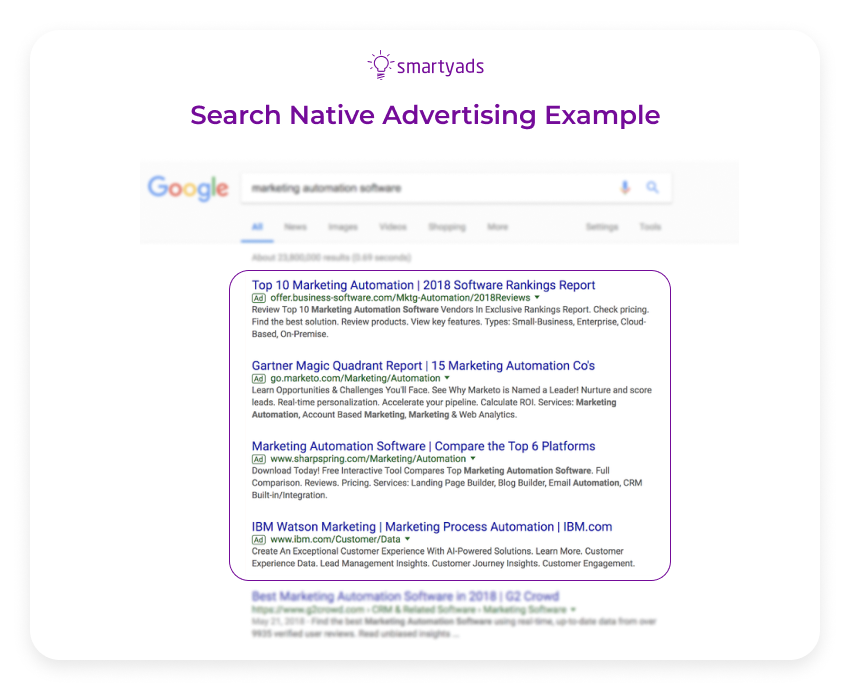
Think about it when you look something up online. Native search ads appear as if they belong there, offering useful information matching your query. It's like finding a helpful tip right where you expected it, without abrupt interruptions.
In digital advertising, paid search ads are designed to make your online journey smoother. They're crafted to be helpful companions to your searches, offering relevant suggestions that feel like a natural part of your exploration.
So, as you navigate the vast expanse of the Internet, paid search ads guide you with a friendly hand, ensuring you find what you need seamlessly and efficiently.
Native video ads
Native video ads are another type of native advertising, like commercials that fit right into the videos you watch online. They're designed to match the style of the videos, so they don't stand out as separate ads.
Picture watching a fun video on your favorite website or social media app. Suddenly, a native video ad pops up but doesn't interrupt your video-watching. Instead, it's like a mini-show that goes along with what you're already enjoying.
These ads aren't pushy or annoying. They're actually interesting and related to what you're watching. Let's say you're watching a cute animal video. A native video ad might show you a cool new pet product that fits right in with the theme.
Native video ads are all about making your online experience better. They're ads that don't feel like ads, adding a little extra fun or useful info to the videos you love. So, as you watch and explore online videos, watch for these friendly native ads that blend right in!
Special Projects
A special project stands as an intricate and expansive advertising endeavor, surpassing the scope and scale of traditional forms of native advertising. It extends beyond a mere article, evolving into a comprehensive series of publications.
It transcends the boundaries of a simple gamified test, blossoming into a fully immersive game with native elements. It goes beyond a routine expert interview, morphing into a comprehensive research endeavor.
These special projects often weave together diverse content forms, creating a tapestry that includes photography, video, text, infographics, animation, and interactive games. It's a symphony of media that harmoniously coalesces to captivate and engage the audience.
Special projects can be cross-media, effectively harnessing multiple channels in tandem. This could encompass the media platform, a dedicated label, the advertiser's website, and various social networks. The synergy of these channels culminates in an orchestrated narrative that resonates across various avenues of engagement.
Bottom line
Native Advertising opens the door to a world where advertising seamlessly blends with content, captivating audiences through interactive engagement, visual allure, and authenticity. It's a user-centric approach that elevates the advertising landscape and transforms it into a meaningful and integrated experience.
By the way, you can run almost any type of native advertising with SmartyAds DSP.

